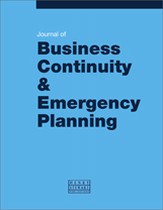Designing and implementing an interdependent resilience culture
Abstract
Once an emergency occurs, companies find themselves competing for diminishing resources. Companies mired in confusion and debate often fail to obtain the resources necessary for a speedy recovery and fail to meet the expectations of their various interested parties. Unfortunately, it is during these emergencies that the firm is judged. Unfavourable evaluations of a company by customers, the government and/or the general public result in lost future revenue through contracts that are either not renewed or cancelled, as well as disqualification from tenders and lost bids. This paper discusses how an oil field services company implemented an interdependent resilience culture. Development of this culture included paring down complex concepts and theories into simple rules that are continually introduced and reinforced to the company’s leadership. After years of effort, employees from the well head to the corporate boardroom are aligned and aware of everyone’s roles when an incident occurs. In short, because each person can count on the others, the company quickly adapts and overcomes significant issues, adding to its competitiveness. As a reader, you will understand that the results of implementing this new culture come down to a single metric: speed. Responses become faster, decisions faster, communication and the transfer of knowledge faster. Emergencies are dynamic and ever-changing. Information quickly becomes stale and outdated. Installing this culture creates a more nimble company which reacts in a manner that allows for extra time, so all the unplanned delays, pitfalls and breakdowns can occur with little to no meaningful impact.
The full article is available to subscribers to the journal.
Author's Biography
Knapp Henry Patrick is a graduate of the Emergency Administration and Disaster Planning programme at the University of North Texas and has been the Enterprise Business Resilience Manager with Baker Hughes for the past nine years. This position ensures continuity of critical processes and operations while maintaining operational readiness to respond to incidents, emergencies, crisis and threatening events. Prior to this role he spent 12 years with the American National Red Cross. While with these two organisations, he coordinated humanitarian aid during conflicts in the Balkans and north-east Africa in the late 1990s, served in leadership roles on more than 30 national disasters across the USA, including 9/11, and served as the shelter manager for the four Astrodome shelters in Houston during Hurricane Katrina in 2005. Recently he facilitated emergency air evacuations and repatriations for northern Africa and the Middle East during the Arab Spring. Patrick holds a licence as a Lead Implementer of ISO 22301 Business Continuity Management Systems. He has served on several task forces and planning committees, from chemical weapons and nuclear power plants to aviation disasters, pandemics and earthquake consortiums in California and central USA. In his current role he focuses on the development of incident response, business continuity, disaster recovery and crisis communication efforts for Baker Hughes worldwide.
Citation
Henry Patrick, Knapp (2016, September 1). Designing and implementing an interdependent resilience culture. In the Journal of Business Continuity & Emergency Planning, Volume 10, Issue 1. https://doi.org/10.69554/QSQN4412.Publications LLP
